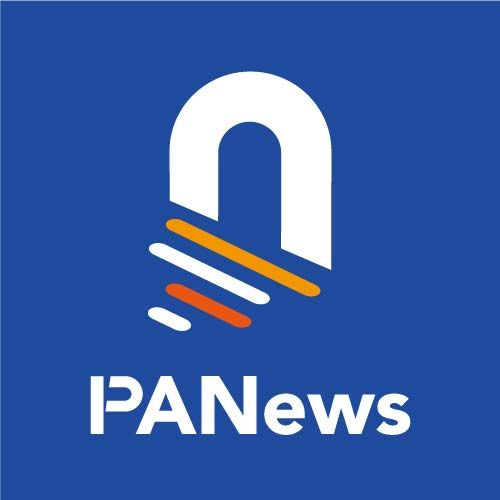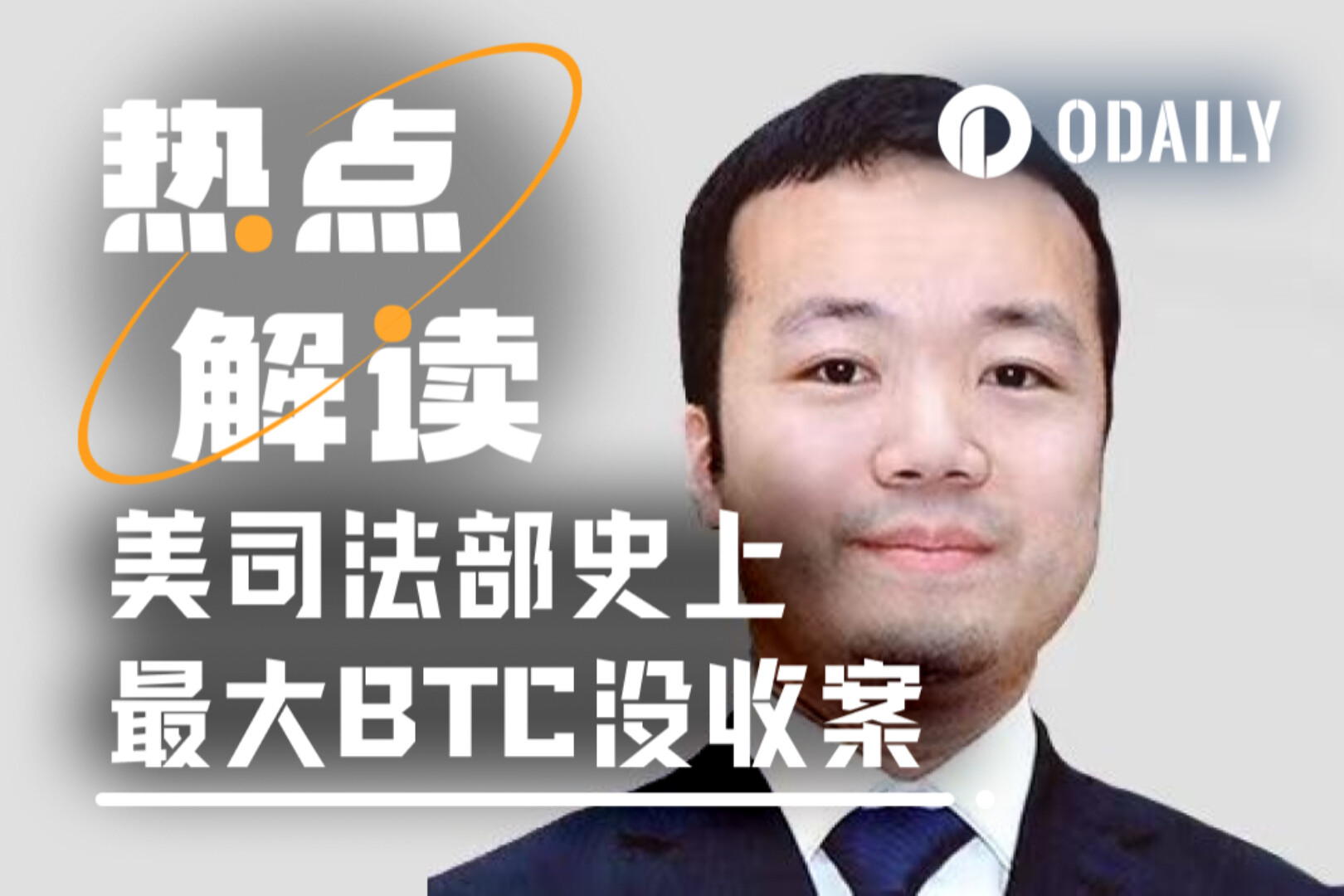Original author: JAE, PANews
Real estate, new energy, innovative drugs, travel... The RWA (Real-World Assets)-related announcements from Hong Kong-listed companies in various sectors are like pebbles dropped into a pond, stirring the stock market and stirring the nerves of investors. Eyeing the soaring stock prices of the pioneers, many listed companies are stepping up their learning and exploration of RWA or digital asset businesses.
RWAs are widely touted for their theoretical advantages, such as increased asset liquidity, lower investment barriers, and simplified transaction processes. However, the underlying complexity and high costs of implementation are less widely known. In reality, RWA projects are more than simply putting assets on the blockchain through technology; rather, they involve a complex exercise in balancing business models, legal compliance, and technological innovation.
Which types of assets are suitable for tokenization?
The core definition of RWA is to tokenize real-world tangible and intangible assets, such as real estate, private equity, bills, bonds, etc., through blockchain technology, so that they can be circulated, traded and used in the crypto market.
However, RWA tokenization isn't a universal option for all assets; the quality and type of the underlying assets are crucial. An RWA asset suitable for tokenization must possess a certain level of intrinsic value to attract significant on-chain liquidity. At an RWA offline event hosted by PANews, several guests discussed what assets are suitable for RWA.
First, standardized and highly liquid assets are paramount for the successful issuance of RWA products. Mao Jiehao, a senior attorney at Shanghai Mankiw Law Firm, noted that in terms of compliance and smooth issuance, financialized products such as money market funds and U.S. Treasury bonds are the ideal path for RWA tokenization.
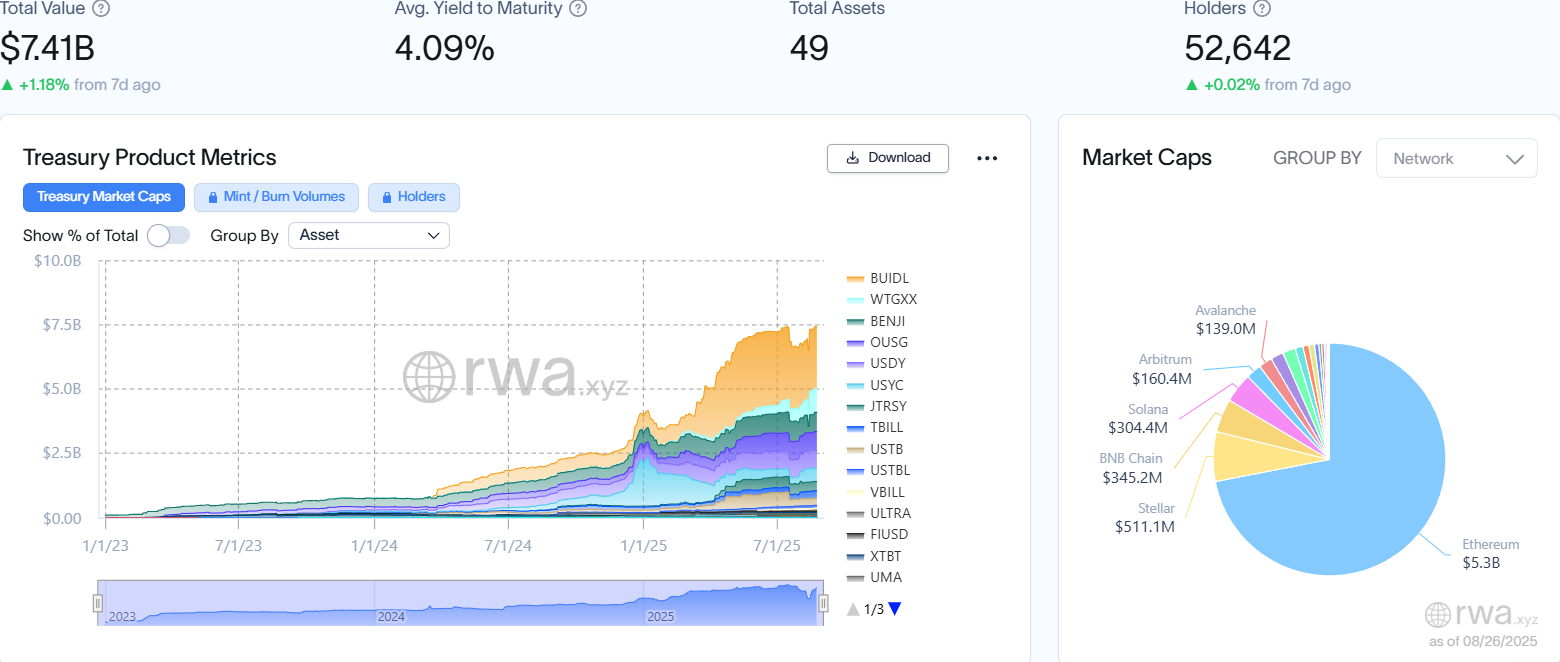
Secondly, the yields of RWA products must be sufficiently competitive. Conflux co-founder and COO Zhang Yuanjie, explaining the Ethena protocol's basis hedging strategy, emphasized that the returns of RWA assets must not only compete with risk-free rates in the TradFi market (such as US Treasury yields) but also compete with the yields of DeFi protocols. To attract more capital, many RWA products adopt a "double-yield" model: the returns of the underlying assets are combined with additional token incentives, thereby providing investors with higher potential returns.
On the other hand, while some non-standard assets offer compelling narratives, they face numerous challenges in actual implementation. Zhang Yuanjie believes that while some photovoltaic battery swap projects on the market offer excellent examples of tokenized non-standard assets linked to the real economy, their scalability and liquidity are limited. These "much-hyped" but ineffective projects, as they fail to meet the market's core requirements for replicability, scalability, and high liquidity, should not become mainstream RWA assets.
RWA's value proposition possesses unique market attributes. Zheng Lijiang, Research Manager at Shanghai Wanxiang Blockchain Co., Ltd., believes that RWA's core advantages lie in: 1) Global price discovery and 24/7 liquidity: Traditional financial asset transactions are strictly restricted by time and location. RWA, however, enables seamless, 24/7 trading and global pricing through blockchain, significantly improving the timeliness and liquidity of asset transactions. 2) Composability and universality: RWA's key advantage lies in its programmability. Once assets are on-chain, they can serve as "Lego blocks" in the DeFi ecosystem, integrating or combining with other protocols to create new financial products and application scenarios. Furthermore, its universality theoretically significantly lowers the barrier to entry, allowing any investor to participate in asset issuance and investment, thereby broadening investment horizons. 3) Issuance efficiency: Compared to conventional asset securitization instruments (such as ABS or REITs), RWA offers significant advantages in terms of issuance cycle and certain costs. For example, it eliminates many cumbersome intermediaries and paperwork, significantly improving the efficiency of asset issuance.
However, behind the hype surrounding RWAs, there are also some common industry misconceptions, such as: 1) Everything can be put on a blockchain, making financing easy: This is a common misconception in the industry. Putting an asset on a blockchain does not automatically guarantee fundraising. Whether a project or asset can secure financing fundamentally depends on its intrinsic value, rate of return, and risk-return ratio. Blockchain simply provides a new, more efficient platform, but the underlying logic of financing remains unchanged. 2) Asset tokenization is roughly equivalent to asset securitization: Asset securitization addresses the issue of "fractionalization" of ownership, and viable solutions existed before the emergence of RWAs (such as REITs). The core functionality of tokenization is not limited to ownership fragmentation; it offers advantages such as global price discovery, composability, and universal applicability that traditional securitization tools cannot offer.
To sum up, RWA is positioned more as an "overlay" rather than a "substitute". It does not replace the rigorous due diligence obligations and asset securitization model in TradFi, but rather empowers assets with the technological advantages of blockchain, enabling them to circulate and increase in value in a global, programmable crypto market, thereby creating richer liquidity and application scenarios for assets.
How much does it cost to do an RWA project?
Because RWA projects involve different business model choices before launch, they also result in different cost structures. In an interview with PANews, Roy, founder of District Consulting, revealed that in Hong Kong, for example, RWA projects can be divided into two models: a single issuance of an RWA product and a long-term development of the RWA business.
A single issuance of an RWA product means that the issuer completes the tokenization and fundraising of a specific product only once. The cost range is usually between RMB 3 million and RMB 6 million. The high cost is composed of multiple key links, among which brokerage fees play a dominant role.
Legal compliance is the cornerstone of RWA product issuance, costing between 100,000 and 200,000 RMB to establish an SPV (Special Purpose Vehicle) structure and ensure cross-border compliance, particularly with regard to the compatibility of the legal systems of mainland China and Hong Kong. Establishing an SPV is a key step in defining legal ownership, isolating asset risks, and ensuring that the rights and interests of the assets represented by the tokens are traceable and verifiable. Cross-border compliance is even more complex, requiring compliance with both mainland China's legal requirements and Hong Kong's Securities and Futures Ordinance (SFO), particularly with regard to capital repatriation and cross-border asset transactions, to mitigate potential legal risks. Legal compliance costs are an essential expense for any regulated RWA project.
The relatively fixed range of legal and compliance costs suggests that the cost of establishing a basic compliance framework is relatively manageable, but the risks of noncompliance arising from improper handling are difficult to assess. If a project fails to operate effectively within the legal framework, all additional investment in technology and fundraising will be wasted. Therefore, legal and compliance costs hold a strategic position among all cost items, determining whether a project can successfully "pass regulations" and achieve legal status.
On-chain technology is the core engine of RWA tokenization, costing approximately 500,000 to 800,000 RMB. This covers public chain integration and asset registration, including smart contract development, security audits, and synchronization of on-chain data with off-chain asset information. Asset complexity is a key variable influencing this cost. Assets with single ownership (such as bonds and real estate) have relatively low technical implementation costs. However, assets with multi-layered profit distribution mechanisms (such as private equity funds) require the development of more complex smart contracts and the integration of on-chain oracles, significantly increasing costs.
Technology selection is a key lever for controlling RWA project costs and also determines the volatility of development costs. The choice of public chain and technical approaches such as the integration of zero-knowledge proofs will directly impact end-user costs. Projects with strong development capabilities and the ability to issue complex assets typically invest more in technology than the market average. This also enables them to design more distinctive and high-dimensional RWA products, creating a differentiated advantage over the competition.
Brokerage access is the "credit endorsement" of RWA projects, and its expenditure is the highest cost item for a single RWA product issuance, reaching as high as 2 to 3 million RMB. This fee is collected by licensed Hong Kong brokerages as a comprehensive pricing for their services, including compliance control, due diligence, issuance access, and product underwriting. As a bridge between TradFi and the crypto market, brokerages' licenses, reputation, and professional services constitute a costly "trust premium."
The underlying logic behind high brokerage fees is closely tied to the difficulty and scarcity of obtaining Hong Kong financial market licenses. Due to the extremely high initial investment and ongoing maintenance costs of obtaining a license, a small number of licensed institutions have gained control of key issuance channels, creating a de facto monopoly. Exorbitant issuance channel fees are the primary means by which licensed institutions recoup their substantial sunk costs. Therefore, brokerage fees are not only the most obvious barrier to entry for RWA product issuance but also the fuel driving the RWA market's evolution towards institutionalization. These fees will select projects with rigorous business plans and sufficient capital, transforming RWA into a well-organized, capital-backed "product."
Fundraising costs are a function of yield and brand awareness, ranging from 2% to 5% of the funds raised . These costs are highly dependent on the intrinsic value and market reputation of the RWA product. The product's yield directly reflects its intrinsic value; higher yields generally reduce fundraising difficulty and costs. Brand awareness, on the other hand, reflects the market's valuation of its creditworthiness. Highly reputable issuers can leverage their brand influence to reduce fundraising costs. These two factors jointly determine the product's fundraising difficulty and cost, demonstrating that the pricing logic of RWA products closely adheres to the fundamental principles of the TradFi market.
The QFLP (Qualified Foreign Limited Partner) conduit fee is a specific cost associated with cross-border capital flows, approximately 1% of the proceeds. This fee is paid to comply with specific regulatory requirements and facilitate the compliant repatriation of mainland funds. Its existence illustrates a key point: if RWA products seek participation from qualified mainland investors, they must pay an additional price for specific compliance requirements and repatriation channels. Issuers must consider conduit fees in target markets when formulating their fundraising strategies.
Promotion and marketing costs are dynamic variables subject to market pricing. Based on current market conditions, RWA promotion and marketing costs are in a "fluctuating" state. As the RWA narrative is on the rise and media outlets are eager to cover emerging sectors, early promotion and marketing efforts are largely independent, allowing distributors to attract attention at a relatively low cost. However, this low-cost model is unsustainable. As the RWA market continues to develop and competition intensifies, as the market transitions from the "early" stage to the "mass" stage, professional public relations, marketing, branding, advertising, and other services will become essential, significantly increasing promotion and marketing costs.
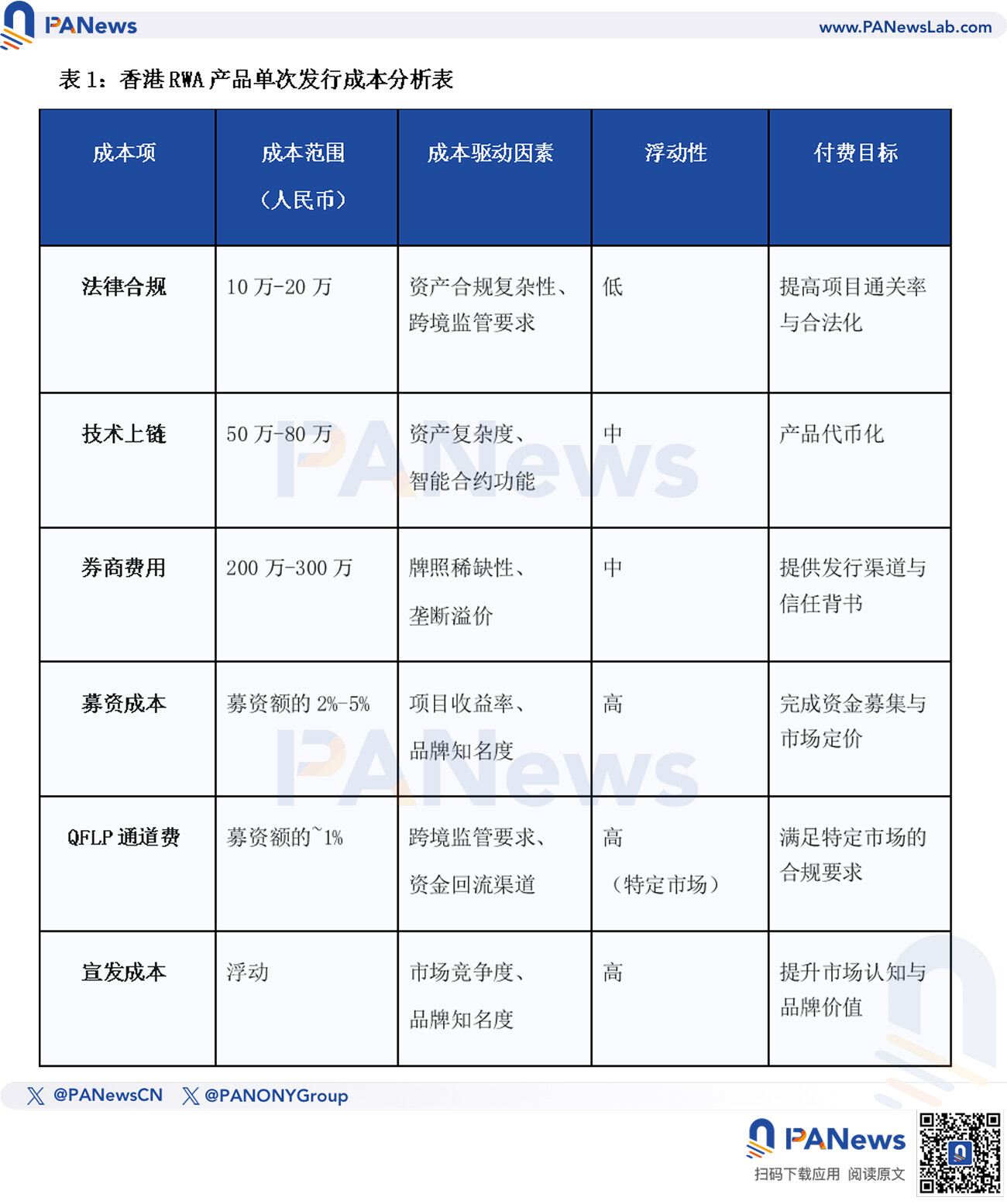
For project developers planning to expand into the RWA sector in Hong Kong, the cost of a single product issuance is just the tip of the iceberg. Large-scale business deployment and compliance maintenance will pose even greater funding challenges. While these fixed costs are high, they will also form a competitive barrier and "moat" for project developers.
The initial investment in preparing for RWA business in Hong Kong mainly includes two aspects. The first is the establishment of an offshore structure, which costs approximately RMB 300,000 and is a necessary step in expanding international financial business.
The second, more critical and costly, step is license application. Different license types will determine the breadth and depth of a business. License Type 1, costing over 1.5 million RMB, allows for direct securities trading and serves as the foundation for token circulation in the secondary market. License Types 4 and 9, costing between 1 million and 1.5 million RMB, focus on providing securities consulting and asset management services. A VASP (Virtual Asset Service Provider) license, the highest level of license for token issuance and trading, is particularly expensive, creating a significant barrier to entry for the RWA sector. HashKey once spent tens of millions on this license. The significant sunk costs of applying for a VASP license have directly divided market participants into two categories: the small number of licensed, well-capitalized "business parties" and the majority of "product parties" who rely on channels and incur significant fees for each issuance.
Operating an RWA business requires long-term fixed investments. The core of ongoing capital expenditures is "people," specifically professional audit, compliance, and legal personnel. Human resources are crucial to ensuring the validity of licenses and maintaining legal operations. These costs primarily include annual audit/legal fees and license maintenance fees. Audit/legal fees start at approximately 100,000 RMB in mainland China, and as an international financial center, professional service fees are higher in Hong Kong. License maintenance fees vary significantly, with Type 4 and Type 9 licenses offering lower costs. However, Type 1 and VASP licenses require dedicated internal compliance teams and rigorous annual audits, resulting in significantly higher maintenance costs than standard licenses.
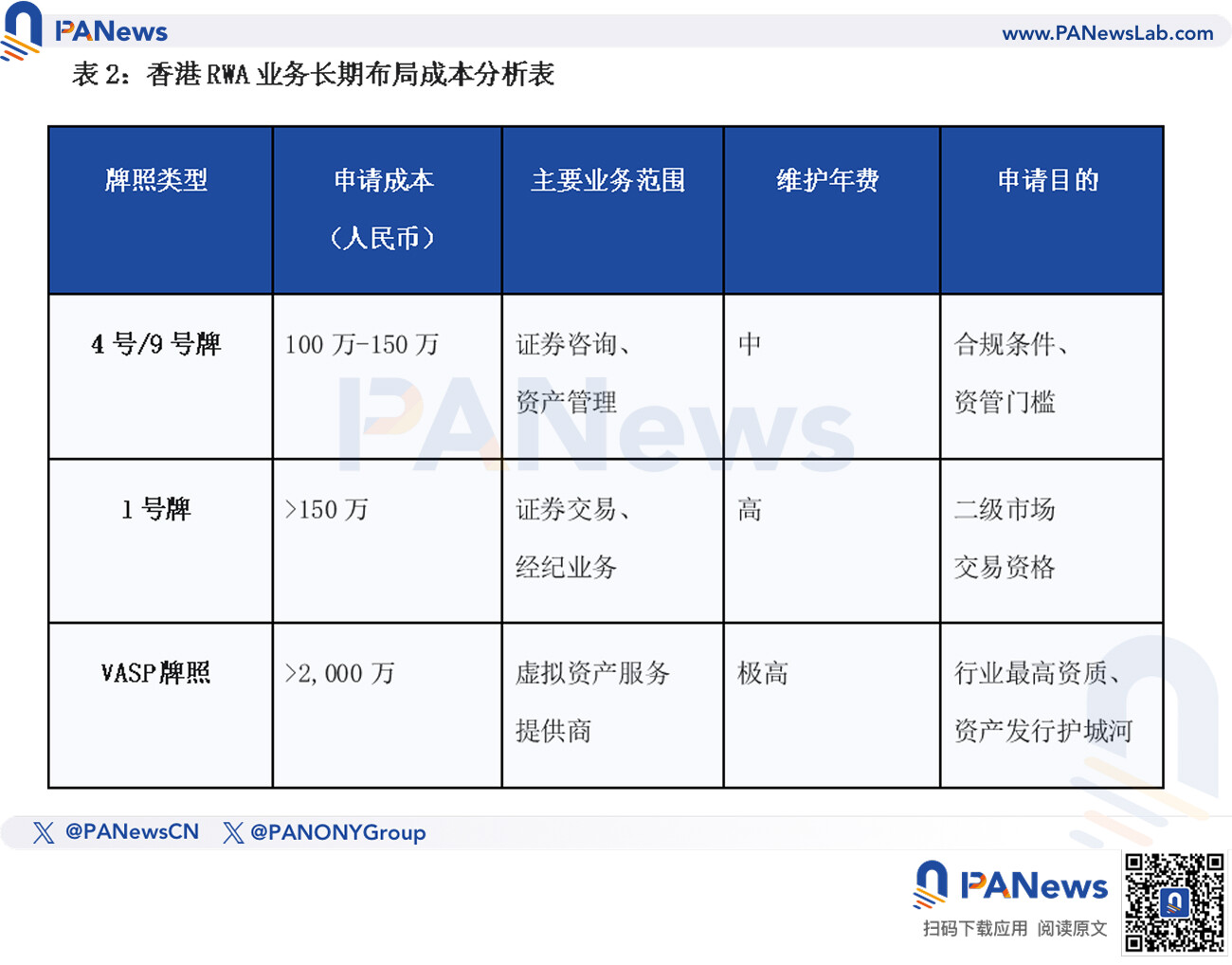
The "asset-heavy" cost structure of RWA projects has gradually shown an "oligopolistic" trend, especially the high cost and capital requirements of license applications, which effectively screen out project parties with strong capital strength.
What are the key constraints facing RWAs?
In addition to cost barriers, the implementation of RWA projects also faces structural bottlenecks at the ecosystem level.
The first challenge is technical infrastructure. Cheng Yuan, an anti-money laundering product expert at Certik, pointed out that blockchain infrastructure, such as oracles and cross-chain protocols, is still in its infancy and presents single-point risks. For example, Chainlink currently dominates the oracle market. If it were to encounter problems, it could lead to systemic risks for the entire DeFi ecosystem, with consequences for RWAs that require synchronizing off-chain data.
Secondly, there's a shortage of interdisciplinary talent. Zhang Yuanjie mentioned the industry's current shortage of asset managers proficient in both TradFi and DeFi. This lack of talent makes it difficult for many RWA projects to effectively integrate off-chain assets with on-chain protocols, hindering the full realization of RWA's value proposition.
Finally, there's the lack of on-chain distribution channels. Zhang Yuanjie pointed out that the current reliance on DeFi protocols within the Ethereum ecosystem for distribution of RWAs is becoming increasingly severe. Localized on-chain distribution channels are severely lacking in the Asia-Pacific region. This means that even if high-quality assets exist in the region, it's difficult to establish a complete liquidity cycle locally, which in turn limits the fundraising and circulation of local assets. Due to the immaturity of the local on-chain ecosystem in the Asia-Pacific region, RWA products in Hong Kong have consistently chosen off-chain brokerage distribution channels rather than DeFi protocols.
On-chain distribution channels offer advantages in cost, globalization, and composability, but they struggle to meet regulatory requirements. Conversely, off-chain brokerage channels offer advantages in trust, localization, and compliance, but they are also extremely costly. Both distribution channels have their pros and cons. For Hong Kong specifically, off-chain brokerage distribution may be a more suitable solution.
It can be seen from this that the large-scale implementation of RWA is not only a local issue of supervision or cost, but a systemic challenge composed of technology, talent and channels.
- 核心观点:RWA代币化落地面临高成本与复杂挑战。
- 关键要素:
- 单次发行成本300-600万元。
- 券商费用占主导,达200-300万元。
- 法律合规与技术成本各需10-80万元。
- 市场影响:推高行业门槛,加速机构化进程。
- 时效性标注:中期影响。


